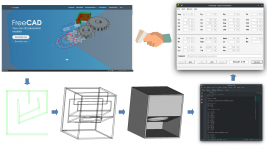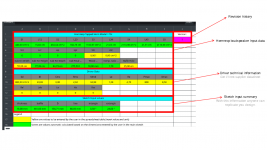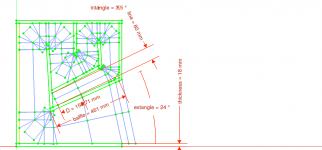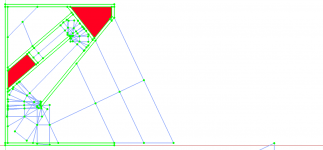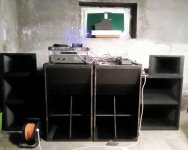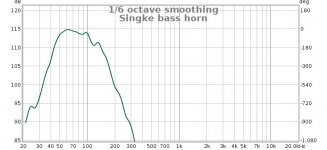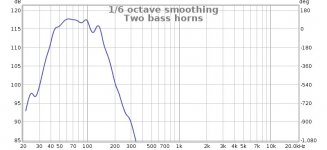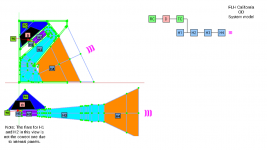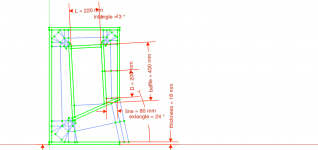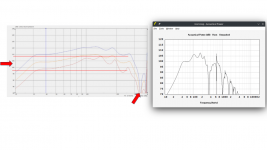Hello,
Here you will find CAD files for many different loudspeakers layout that you can adjust dimensions to better fit your driver's Thiele-Small parameters. Use it to design your custom solution or to replicate well-know projects developed from others.
The advantages of this tool are:
The files were created using the FreeCAD that is very easy to use and the data were defined in a ways that even people that don't have knowledge about CAD software can still use and enjoy it.
Fell free to ask for support or additional plans.
https://freeloudspeakerplan.rf.gd
Here you will find CAD files for many different loudspeakers layout that you can adjust dimensions to better fit your driver's Thiele-Small parameters. Use it to design your custom solution or to replicate well-know projects developed from others.
The advantages of this tool are:
- Free and open-source software
- Embedded spreadsheet with hornresp inputdata
- Macro script to export hornresp *.txt inputdata
- Fully parametric Sketch
- 3D model
The files were created using the FreeCAD that is very easy to use and the data were defined in a ways that even people that don't have knowledge about CAD software can still use and enjoy it.
Fell free to ask for support or additional plans.
https://freeloudspeakerplan.rf.gd
Attachments
What about California bass horn ?
Hello, post the plan here and I can work and try to implement it.
Thanks LordSansui, here it isHello, post the plan here and I can work and try to implement it.
Thanks LordSansui, here it is
Hello JLOP,
I'm implementing the California Plan and this loudspeaker is a Front Load Horn with sealed chamber, this particular design present a waist of internal space as you can see highlighted in red in the attachment #1. There are two chambers that doesn't look connected to the sealed one where the driver is installed. In addition, the design is complex and will require 3 main sketches becoming not much friendly.
Do you still prefer to use this design or you could try to achieve a similar result using POSH design already available in the website with a lot of freedom like to increase mouth size and increase the compression ratio as well, or as an option I could implement also the SuperBassHornv as you can see the plan in the attachment #2, It has longer horn length and I think you can achiever even better results. I could give you a freedom to change the flares mainly for the H1 segment and probably it can assume straight flare to behave more like a throat chamber/adapter, I never compared both solution but I has the impression. What do you think?
General Note: It's also important to mention that quoating (dimensioning) a loudspeaker to manipulate parameter in order to be aligned with hornresp models in general is different them quoating (dimensioning) to build, so sometimes we can not achieve exactly the same dimensions besides we can be close enough, I also need to make some small changes in the design to better fit to hornresp model also because some models were designed using different softwares witch allow more freedom compared to hornresp. OTHORN is an example.
Attachments
Very nice work! Also interesting that you managed to get the site registered under the "GD" root domain, which is the root domain for my island, Grenada.
Thank you, it was the simplest one I found available in the list offered from infinityfree.net web server as a free option. And so you live closer to Brazil them to USA
Hi LordSansuiHello JLOP,
I'm implementing the California Plan and this loudspeaker is a Front Load Horn with sealed chamber, this particular design present a waist of internal space as you can see highlighted in red in the attachment #1. There are two chambers that doesn't look connected to the sealed one where the driver is installed. In addition, the design is complex and will require 3 main sketches becoming not much friendly.
Do you still prefer to use this design or you could try to achieve a similar result using POSH design already available in the website with a lot of freedom like to increase mouth size and increase the compression ratio as well, or as an option I could implement also the SuperBassHornv as you can see the plan in the attachment #2, It has longer horn length and I think you can achiever even better results. I could give you a freedom to change the flares mainly for the H1 segment and probably it can assume straight flare to behave more like a throat chamber/adapter, I never compared both solution but I has the impression. What do you think?
General Note: It's also important to mention that quoating (dimensioning) a loudspeaker to manipulate parameter in order to be aligned with hornresp models in general is different them quoating (dimensioning) to build, so sometimes we can not achieve exactly the same dimensions besides we can be close enough, I also need to make some small changes in the design to better fit to hornresp model also because some models were designed using different softwares witch allow more freedom compared to hornresp. OTHORN is an example.
Thanks for the excellent analysis. My primary goal is to reproduce from 35-40 Hz to 300 Hz where a large medium bass horn will take the relay, so it is not a subwoofer. High frequency useful limit will be a parameter to consider, probably in HornResponse., as well as smoothness of the frequency response as it is for hifi not PA.
I have also found this variation called "HessBH" that seems a little simpler to build than the SBH, conceptor Alexi makes some fun of the SBH but does not say in detail why he claims to have improved the design. Exterior shape the same. What do you think of it ? Website here but only in french https://soundagency.fr/docs/hessbh-le-sbh-killer/
On the California BassHorn I think the lost space in (2) could be used to slightly increase length, don't you think ? Also the LxW are smaller than HessBH and SBH but H is taller at 74 cm or so.
On the Posh, the mouth seems compromised, or can it be changed to reach the same surface as the others ?
Bests
Jean-Louis
Attachments
Maybe this could be of any interest so someone. Here are drawings and ground plane measurements (SPL level not calibrated) of my bass horns. They use a custom 15" woofer, but the form factor is pretty nice with not too much wasted volume and constant internal width. Solid 40 Hz performance in a pair.
Attachments
They are basically the same loudspeaker and give you the same result, the difference in terms of layout is to give you more or less horn length, Im' going to implement all of them, so you can modify to your taste and check witch one fits better your needs. In a while could play around with POSH and see what you can. or play with the California with the model I'm attaching.
Some of this FLH have more then 4 flares, but Hornresp can simulate only up to 4, so this one simplification I do in the model.
There is the Rog Mogale versions 185horn and 186horn.
Some of this FLH have more then 4 flares, but Hornresp can simulate only up to 4, so this one simplification I do in the model.
There is the Rog Mogale versions 185horn and 186horn.
Attachments
It looks like a clone of Cerwin Vega SL36Maybe this could be of any interest so someone. Here are drawings and ground plane measurements (SPL level not calibrated) of my bass horns. They use a custom 15" woofer, but the form factor is pretty nice with not too much wasted volume and constant internal width. Solid 40 Hz performance in a pair.
On the Posh, the mouth seems compromised, or can it be changed to reach the same surface as the others ?
Yes.
In the website there is an image with all the inputs you are able to change and external angle is one of them, check attached image.
Attachments
Yes, very close inspiration I would think, but using a 15" woofer for lower weight and width. I bought these already built when a guy upgraded his PA, I have 4 and they were 8 pieces used for his PA system. Kind of outdated for PA, but good for home, I got them for 130 Eur each, I could not even buy a solid woofer suitable for horns at that price.It looks like a clone of Cerwin Vega SL36
Hello,
New plans released as indicated below:
Tips and tricks are updated with Vrc mention.
https://freeloudspeakerplan.rf.gd/
New plans released as indicated below:
- Altec816
- CLQW
- CW-SL36
- HessBH
- MHB-46
- SuperBassHorn
- Skram
- TH-SS2
- WLX
- WMX
- WSX
Tips and tricks are updated with Vrc mention.
https://freeloudspeakerplan.rf.gd/
I have also found this variation called "HessBH" that seems a little simpler to build than the SBH
Hello Jean-Louis,
I just released new models that will help you like: SuperBassHorn (take a look, its not complex as you think), CW-SL36, HessBH and WSX.
Regarding HessBH, take a close look at the Acoustical Power Response graph it was attached in the PDF plan you shared. I also generated a response from the model I implemented and as you can see in the attachment the response is not so flat, it shown more then 5dB variation and there is a big null close to 300Hz witch might be an issue to integrate with tops. Probably the person who create the file was "smart" to compress the Y-axis to make it look more flat and cut the lower part of the graph to mask the null.
I would suggest you to compare all the Acoustical Power Response from any of your simulations, regardless the model, drive and variations you try, in the same chart witch means with the same axis limits and to do it you can exporting the result from hornresp and importing them from Excel, Libreoffice or REW, only in this way you can see a clear comparison to take a better decision.
Comparing the model you will understand if you need or not an options with throat chamber once it increases build complexity but improves response at the price to increase driver's cone stress. Indor home usage wouldn't be a issue.
Attachments
- Home
- Loudspeakers
- Subwoofers
- Find here Parametric CAD files for loudspeakers plan - Hornresp integrated
